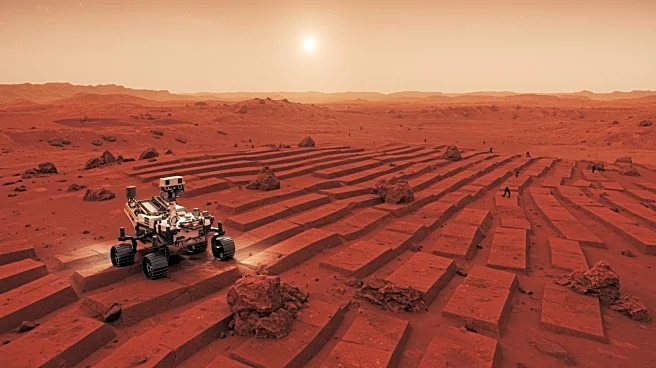What's Happening?
NASA's Curiosity rover is actively exploring the boxwork-forming region in Gale Crater on Mars. Recently, the rover acquired a close-up view of the rock target 'Bococo' at the intersection of several boxwork ridges, revealing bright millimeter-scale nodules likely composed of calcium sulfate. This image was captured using the Mars Hand Lens Imager (MAHLI) on August 10, 2025, during the Mars Science Laboratory mission's 4,625th Martian day. The rover successfully completed a 25-meter drive to a new ridge site, where it conducted several imaging investigations, including Mastcam observations of potential hollow formations and troughs to study fracture transitions from bedrock to regolith. Curiosity's arm was deployed for contact science, with APXS and MAHLI measurements planned to explore local bedrock at two points. Additional observations included ChemCam remote imaging of distant features and atmospheric measurements.
Why It's Important?
The ongoing exploration by Curiosity provides critical insights into the geological history and composition of Mars, which is essential for understanding the planet's past habitability. The detailed analysis of boxwork ridges and the identification of calcium sulfate nodules contribute to the broader scientific knowledge of Martian mineralogy and environmental conditions. These findings can inform future missions and the search for signs of past life on Mars. The data collected by Curiosity also aids in planning for human exploration by identifying potential resources and hazards. The rover's ability to conduct complex scientific operations remotely demonstrates the advancements in robotic space exploration technology.
What's Next?
Curiosity is set to continue its exploration of Gale Crater, with plans to drive to a new location for further contact science on erosionally recessive hollow bedrock. The rover will also conduct imaging to gain a better view of rock layers exposed in the walls of prominent ridges. These activities will enhance the understanding of Martian geological processes and contribute to the preparation for future missions, including potential human exploration. Continued monitoring of the Martian environment will provide valuable data on atmospheric conditions, which is crucial for mission planning and safety.
Beyond the Headlines
The exploration of Mars by Curiosity not only advances scientific knowledge but also inspires public interest in space exploration. The mission highlights the importance of international collaboration in space research and the potential for technological innovations that can benefit humanity. The findings from Mars may also have implications for understanding similar geological processes on Earth, offering insights into our own planet's history and evolution.














